Dan Wowak’s Vision at Coalcracker Bushcraft Blends Training, Tools and Gear
“Every day, we work on making better products and enhancing our teaching to serve the people who matter most—our customers and fellow outdoor adventurers!” —Coalcracker Bushcraft
Dan Wowak, a Mahanoy City, Pennsylvania, native knows this gift very well, because he grew up in the outdoors, hiking and fishing with his grandfather. He says, “The gift of love and appreciation for the outdoors is something I can relate to as priceless.”
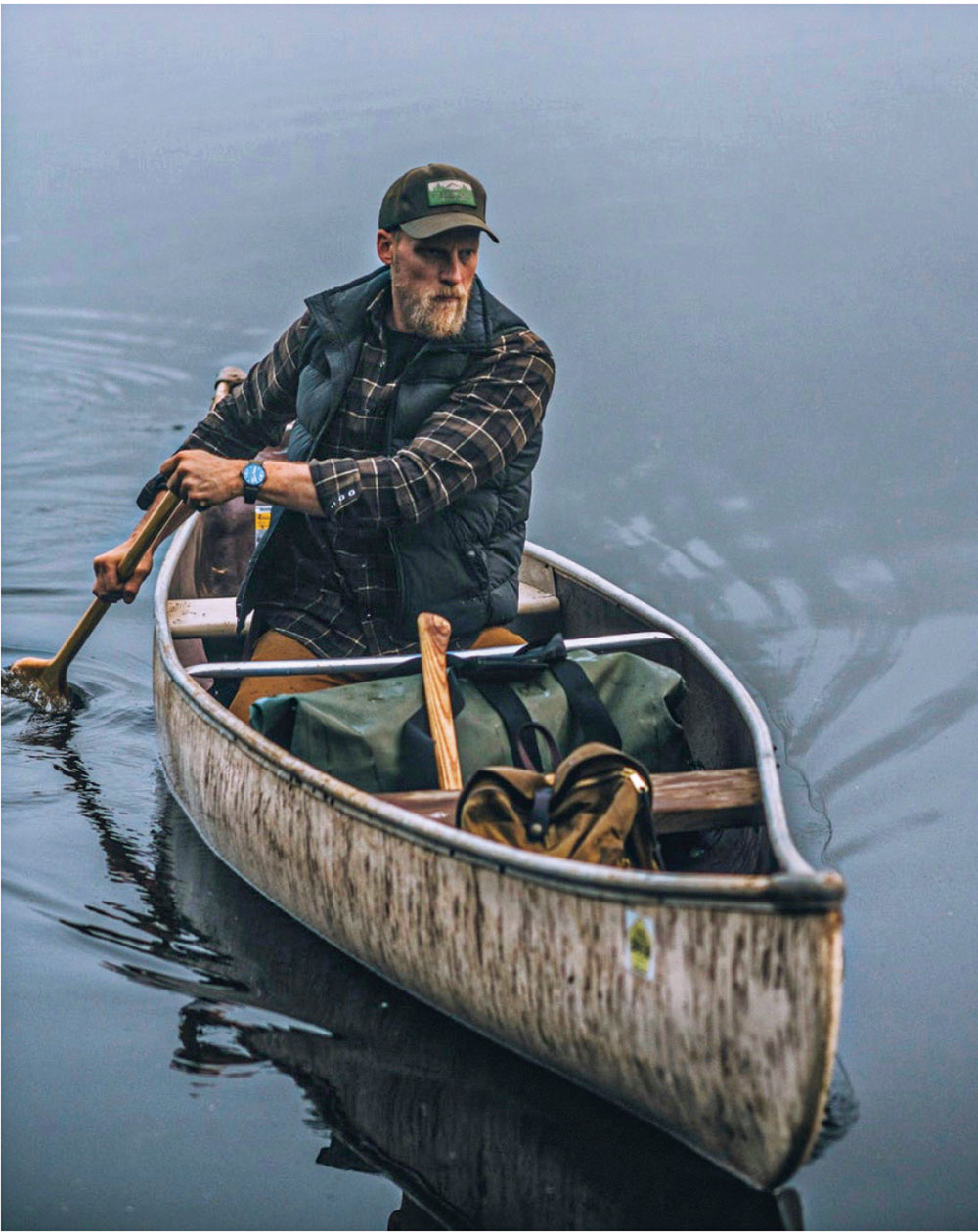
His uncle gave him a military survival manual, which he worked out of as a hobby—or obsession, if you will. This grew into a fiery passion that culminated in a journey leading him to becoming a full-time woodsman in every sense of the word. This journey has taken him to remote areas around the world, including a stint in Patagonia, where he racked up 51 days in the wilderness and appeared in season 3 of the History Channel’s TV show, Alone.
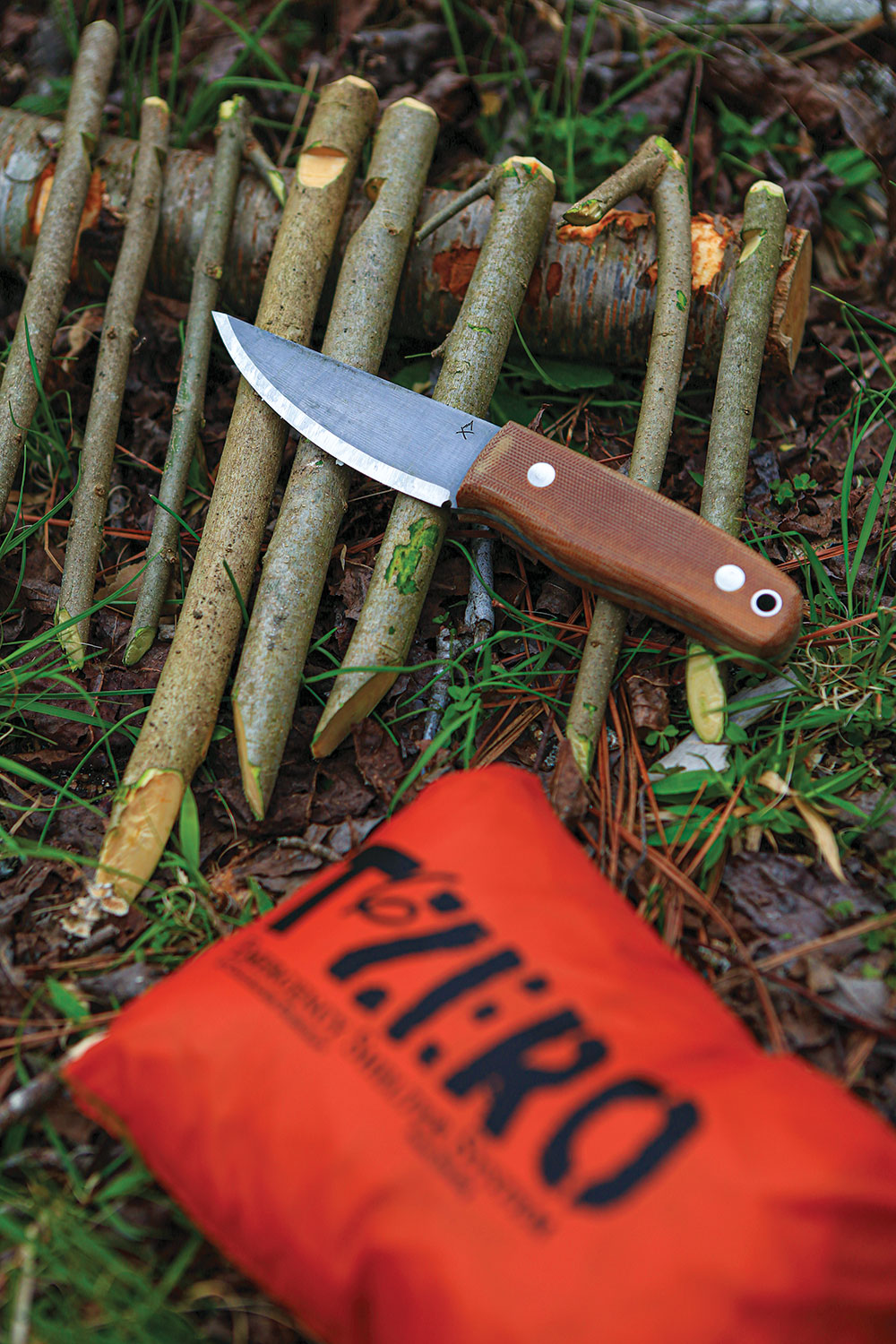
Wowak now owns and operates Coalcracker Bushcraft, which is located in the Appalachian Mountains of Pennsylvania. The company was created in 2016 and consists of a training facility, warehouse and manufacturing shop. The company produces knives, blacksmith and leather goods, sewn items and apparel.
Coalcracker Bushcraft
Since the beginning, Wowak felt it was his company’s mission to create passion for the outdoors. As a teacher and lifelong bushcraft practitioner, he created a series of classes devoted to helping individuals gain a better understanding of the wilderness. Coalcracker Bushcraft courses share outdoor experiences and expertise in the hopes of creating a better and more enjoyable experience for its students.
“Carrying some form of shelter on your person that’s easy to put up—without attaching cordage or needing complicated knots—is what the T6ZERO is all about.”
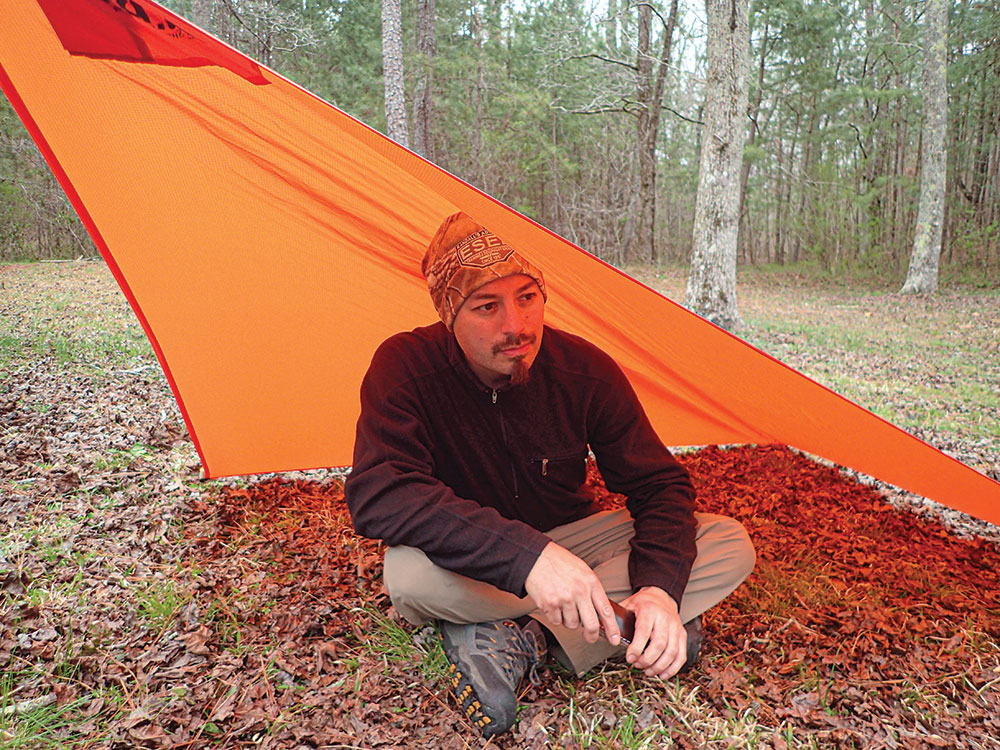
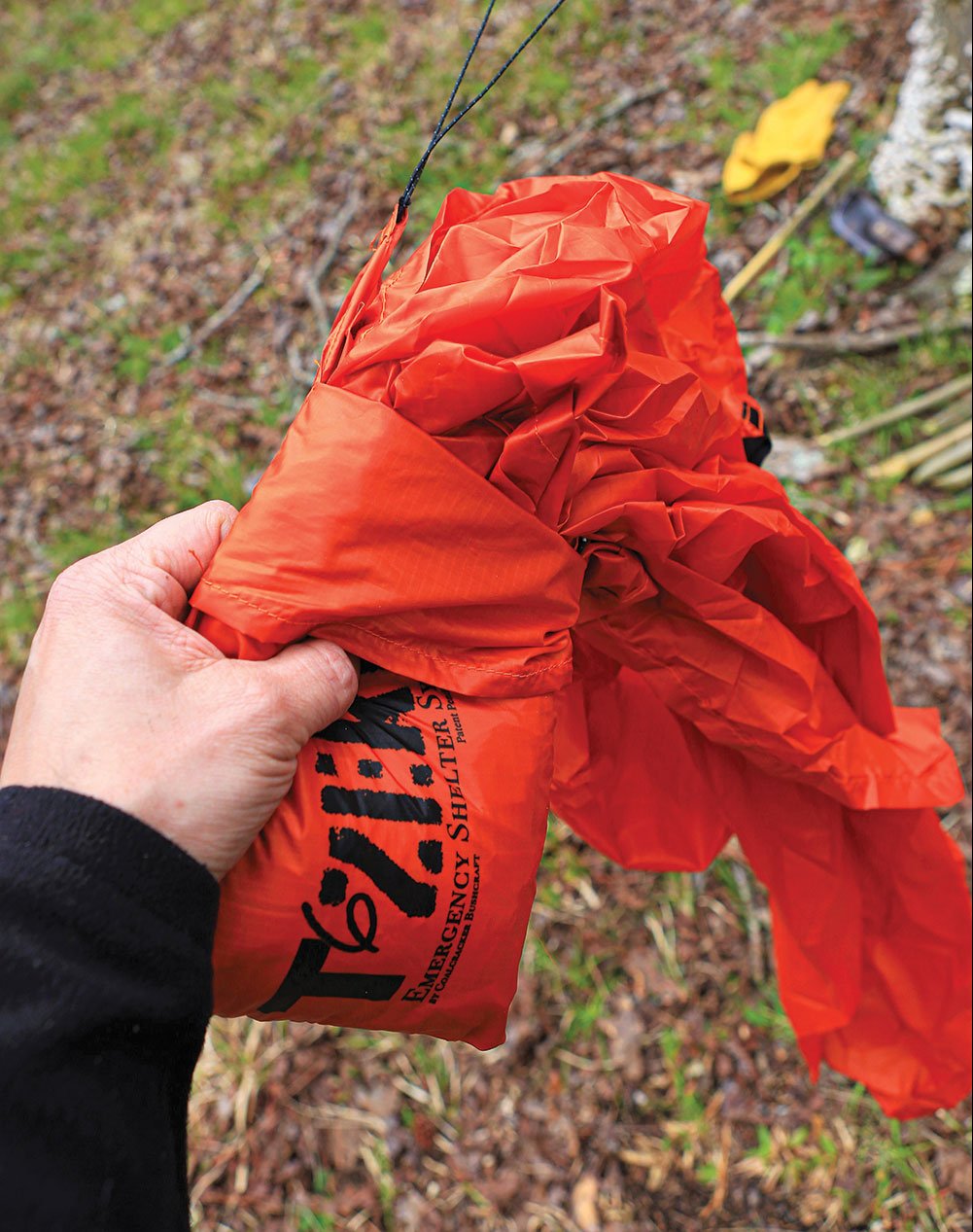
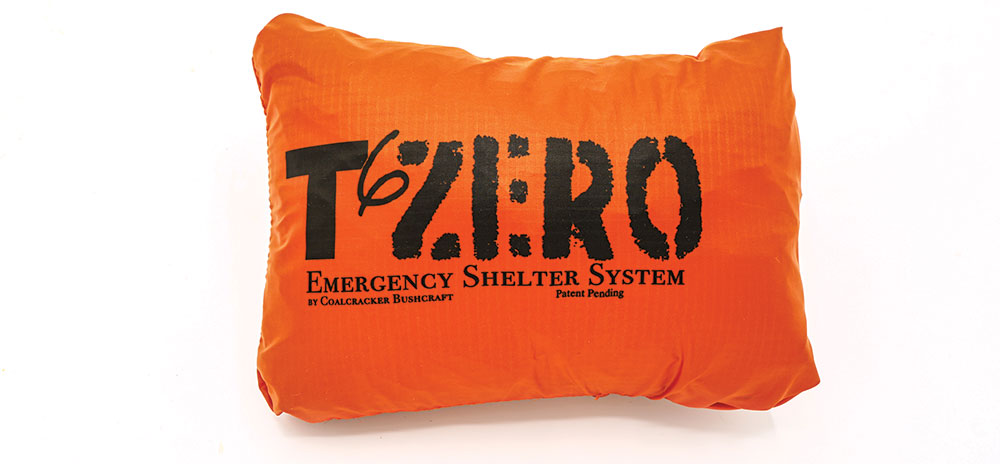
Watching videos of Wowak, as well as visiting the Coalcracker Bushcraft website, got me interested in a few offerings the company produces. One was a rustic-looking leather belt pouch with an antler toggle for use as a “possibles pouch.” Another item was a Scandinavian-ground, fixed-blade knife; and a third item was an orange tarp designed to make it possible to make a shelter immediately.
T6ZERO SHELTER
Specifications
• Orange or green Xenon fabric
• Built-in tie-out lines
• Built-in storage bag
• Ribbon tent peg loops
• Open size: 86×65 inches
• Packed size: 7×5 inches
• Weight: 6 ounces
MSRP: $75
T6ZERO Emergency Shelter
Having the ability to quickly set up a shelter can’t be overstated. Most people who roam the outdoors either have an emergency type of blanket, usually in the form of a Mylar space blanket or plastic garbage bag. While they seem ideal for an emergency, they don’t set up fast and require some jerry-rigging.
“I used this T6ZERO configuration for several days and appreciated its fast setup and takedown—not to mention its weight of just 6 ounces. The tarp’s Xenon fabric is still going strong and will be my go-to backpacking tarp from now on.”
Backpackers and campers carry shelter with them, but how easily and quickly can they be set up? Or worse, what if they get separated from their primary shelter? This could be the result of anything from losing a pack during a river crossing to being run out of camp by a wild animal. Carrying some form of shelter on your person that’s easy to put up—without attaching cordage or needing complicated knots—is what the T6ZERO is all about.
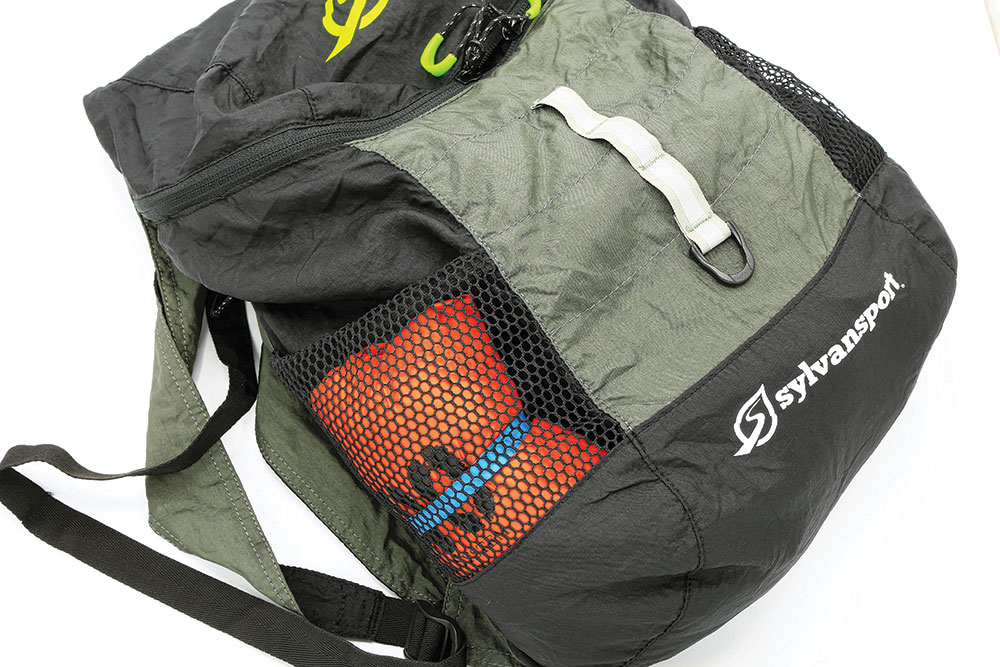
At first glance, this tarp looks plain and ordinary and has an emergency shelter appearance. It’s made from Xenon Sil, a lightweight and low-stretch polyester fabric that’s an excellent material for tarps and tents, for which a waterproof fabric is needed.
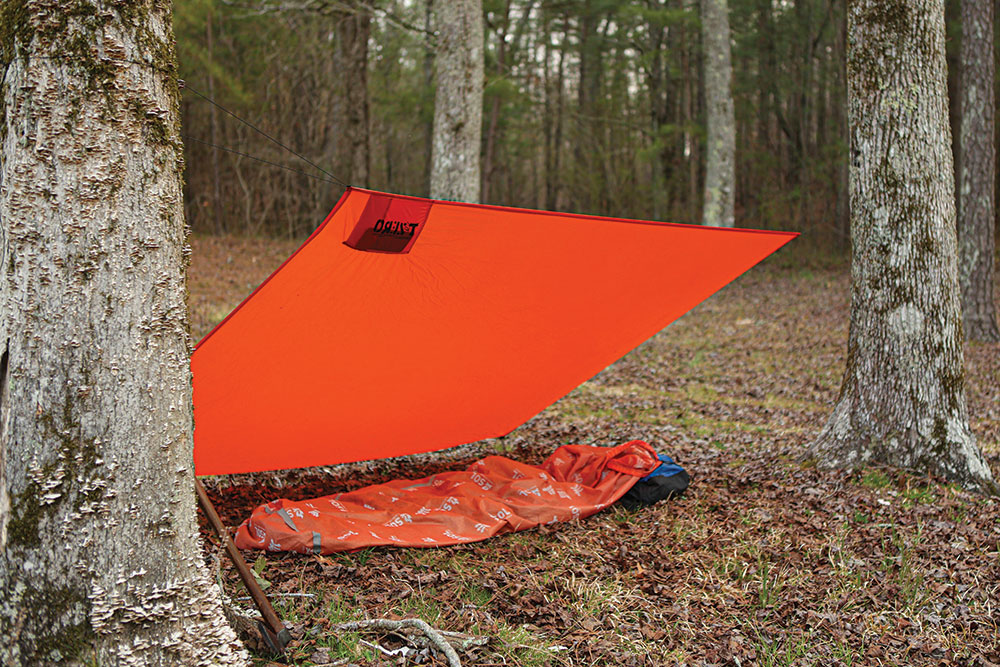
When I received the T6ZERO, orange was the only color offered. Since then, green has been added to the lineup; it makes for a more natural and eye-pleasing backpacker kind of tarp. The T6ZERO is a lightweight, pocketable rectangular tarp that comes with two sets of tie-outs attached and two grommets for staking it down to the ground. The idea is simple: If you can tie shoelaces, you can set up the T6ZERO. All you need are two stakes and two places (such as trees) to tie off to.
In the Field With the T6ZERO
I first started the T6ZERO field test before a heavy snowfall by leaving it on the ground near my semi-permanent camp. It stayed buried in snow for more than three weeks before I retrieved it for inspection. There was no rot or damage.
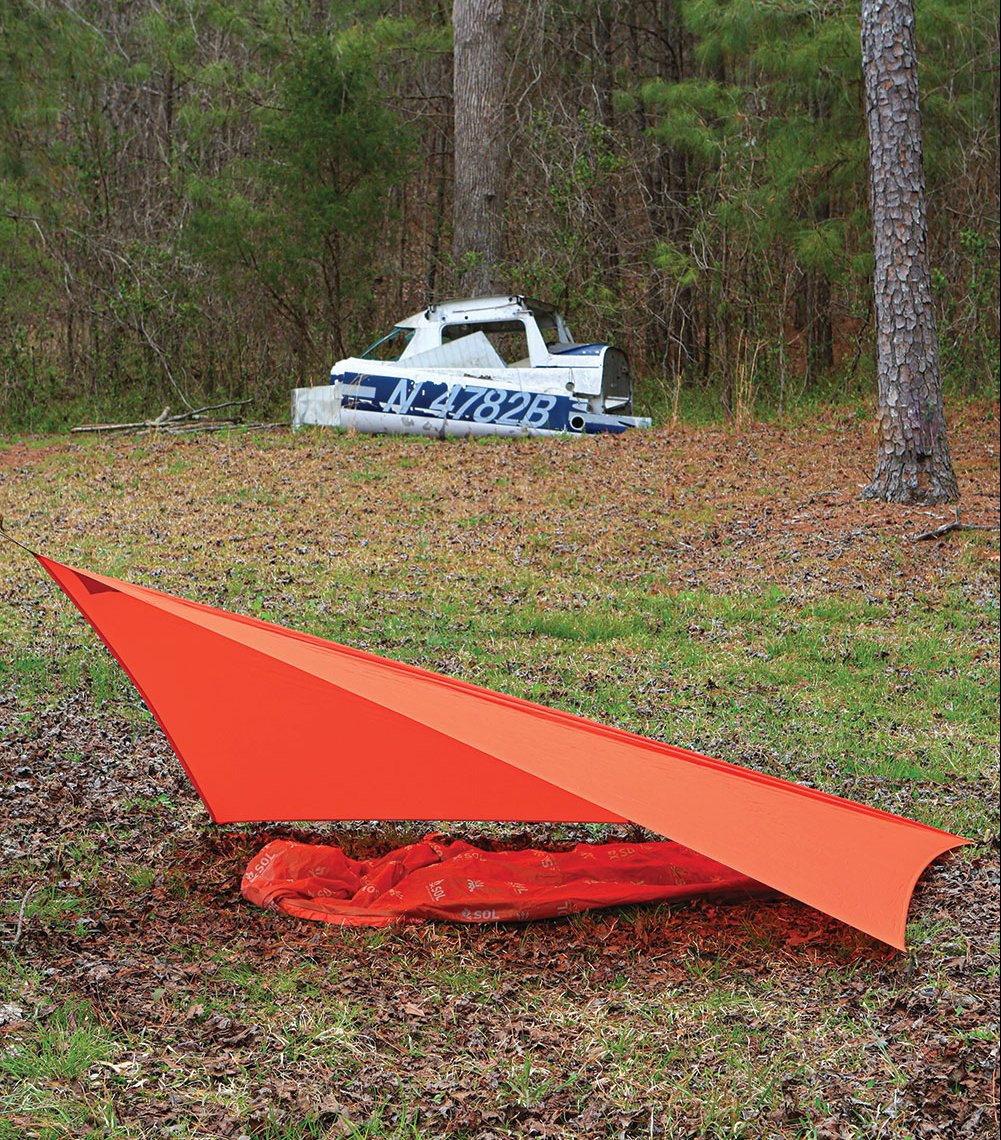
I took the T6ZERO along to use as my primary shelter when I attended a series of classes put on by Randall’s Adventure & Training (in Alabama). I set it up as it was intended—a quick and easy lean-to. I pulled out the cordage, which was a little tangled. Once I got the lines separated, I tied the tarp around a tree at about shoulder height and walked to another tree. Another shoelace knot secured the tarp, and two stakes were inserted through the grommets and pounded into the ground to make the tarp taut. It was that simple.
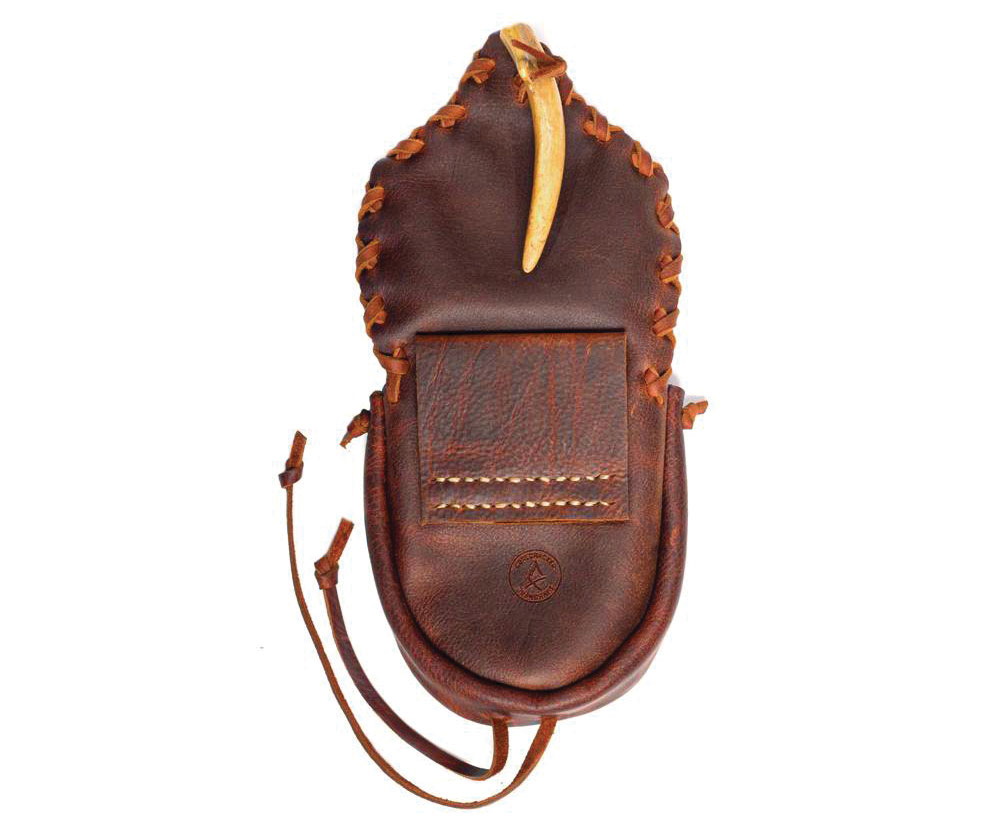
In the morning, I untied one end of the tarp from a tree, made a loop with the cordage as an impromptu grommet and staked the end down with a third stake. Now, it was a “flying diamond” (or “plow point”) setup. This was my favorite choice for wind and rain.
To pack away the T6ZERO, I found it best to slowly bunch up one corner of the tarp with the tie-out to avoid tangling the two lines. I continued tucking and stuffing the tarp into its integral pouch until the last set of tie-outs got neatly tucked away. This method made it easier to deploy the tarp next time.
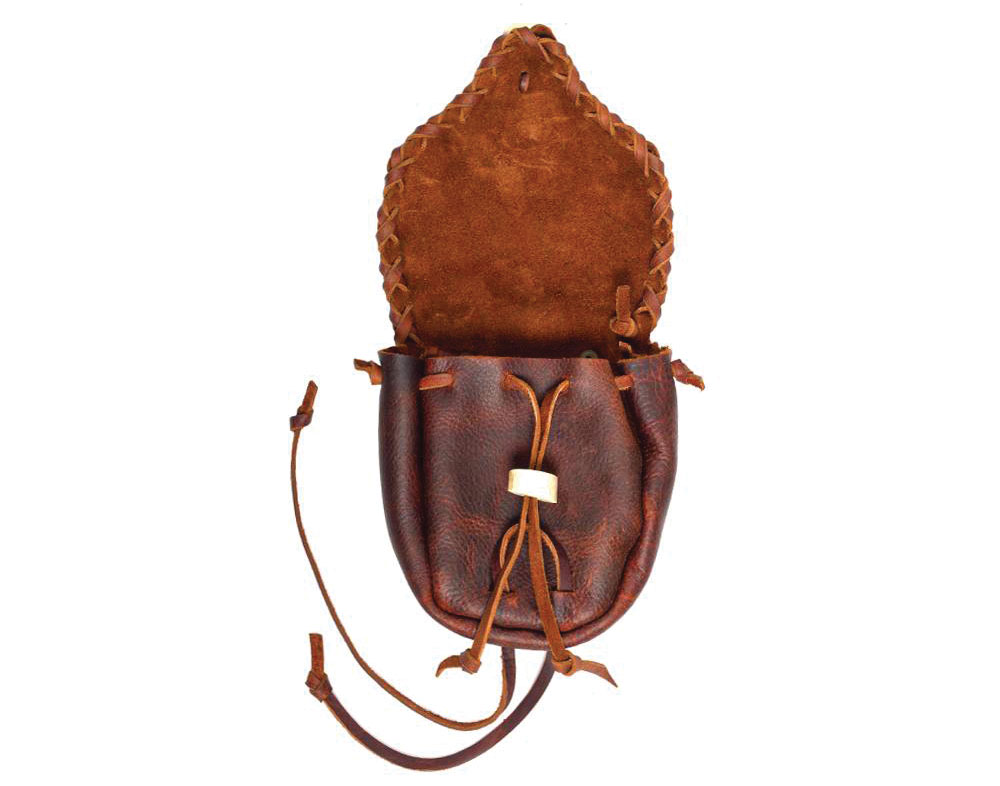
Setting up the flying diamond from the start was also easy. Three stakes were needed, along with a tree. I used the tie-out I packed last and attached it to a tree with a shoelace knot. I took one stake and used the diagonally opposite grommet to tightly pin it down. I put a second stake in the last grommet, pulled it tight and then pinned it in the ground. The last tie-out was also pulled tight (at a right angle) to measure where to pin the last stake. Once the stake was secure, I used the ties to make another shoelace knot and complete the setup.
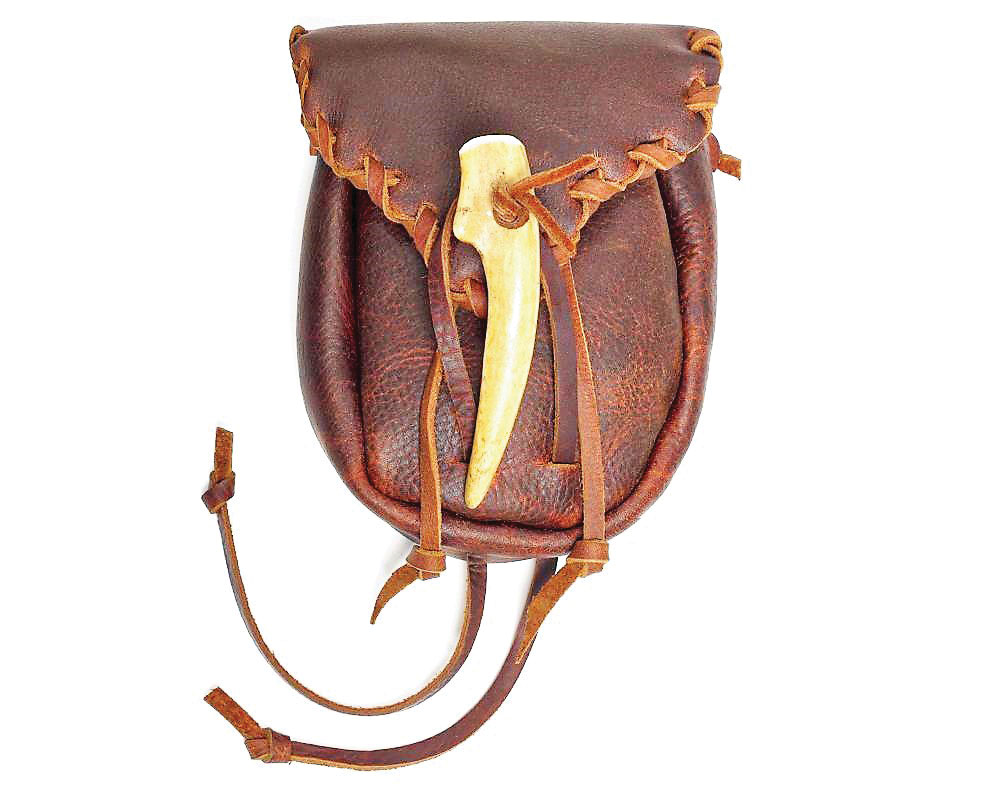
I used this T6ZERO configuration for several days and appreciated its fast setup and takedown—not to mention its weight of just 6 ounces. The tarp’s Xenon fabric is still going strong and will be my go-to backpacking tarp from now on.
Bushcraft Belt Pouch
I’m a fan of carrying a small pouch, either on my belt via carabiner in the warmer months or slung across my torso in the winter, to keep important “woodsy” items at hand.
“I’m a fan of carrying a small pouch, either on my belt via carabiner in the warmer months or slung across my torso in the winter, to keep important ‘woodsy’ items at hand.”
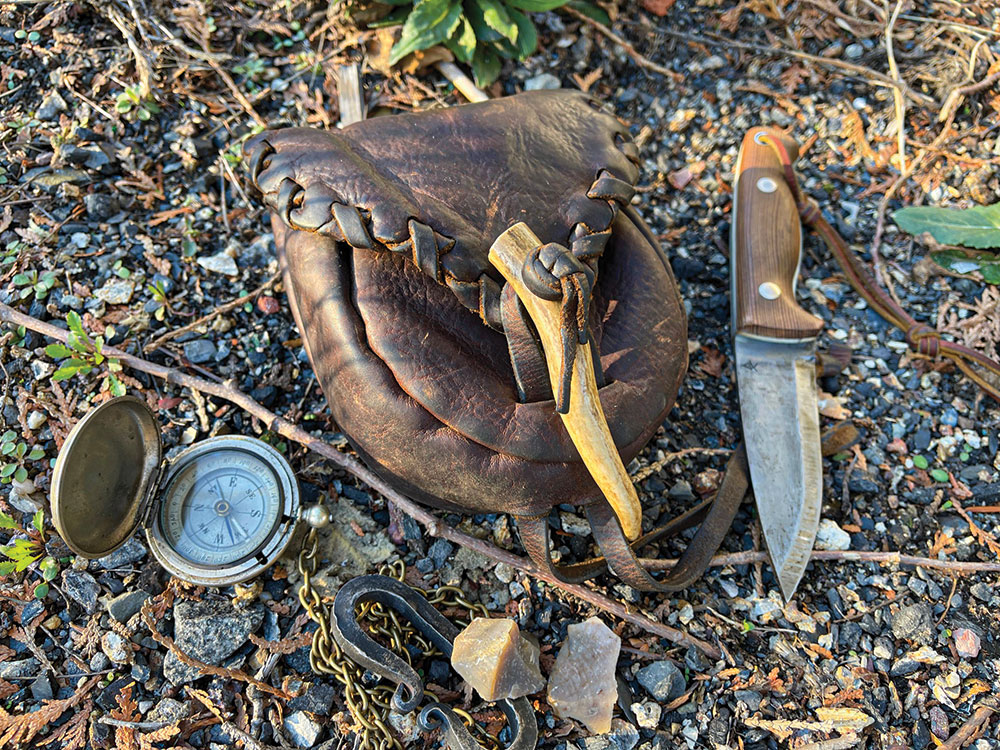
The Coalcracker Bushcraft Belt Pouch caught my attention instantly. It’s made with Kodiak leather—an “old-timey,” rustic, full-grain leather with a lightly oiled feel. Measuring roughly 5×5 inches, the pouch has a drawstring on the inside, and the outside is equipped with a pull string and antler toggle closure. The pouch features a wide sewn and riveted leather belt loop. The whole package weighs in at around 6 or 7 ounces. This pouch, also known as a “possibles pouch,” would carry small items you want to keep track of, along with some redundancies of key kit.
Bushcraft Belt Pouch
Specifications
• Size: 5x5x2 inches
• Brown Kodiak leather
• Internal drawstring closure
• External pull string closure
• External antler toggle
• Sewn and riveted belt loop
• Weight: Approximately 6 or 7 ounces
MSRP: $130
Mineshaft Knife
During one of Wowak’s YouTube videos about blade use, he displayed a knife with a straight spine, 4-inch blade and Scandinavian grind. It had a nice, continuous curve, giving the blade lots of belly, and natural canvas Micarta scales. After some searching, I found the knife on his website; it was listed as the Mineshaft.
“The Mineshaft knife was used for a variety of chores and remained sharp and comfortable … There was no discomfort and no hot spots.”
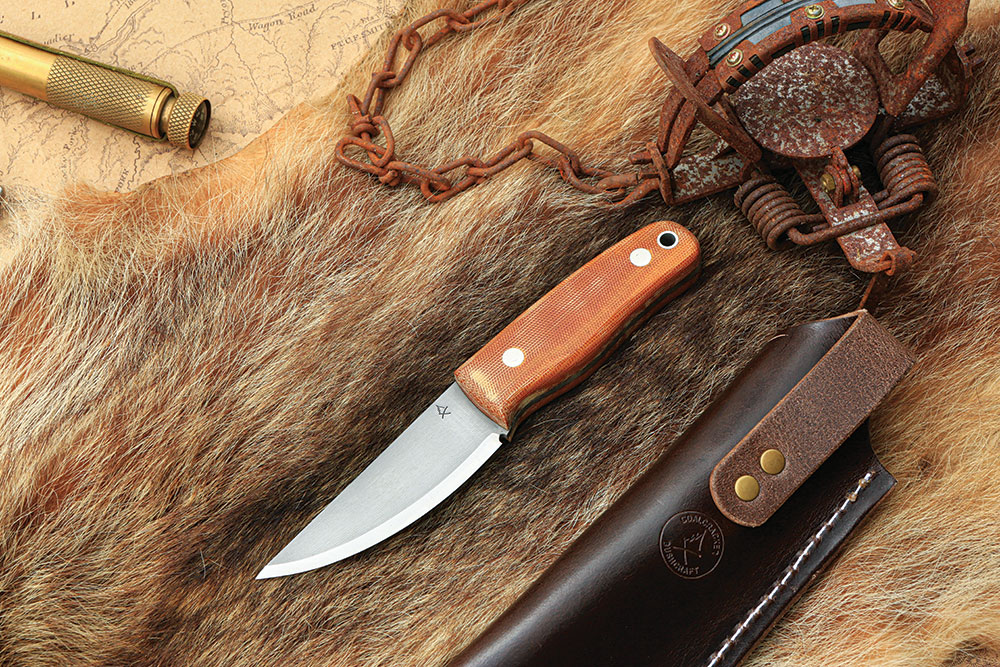
This knife came out of the package ready to work. Esthetically, it looked like a “workhorse” and featured a textured Micarta handle, super-sharp blade and 90-degree spine. I initially felt that the handle was bulky (maybe I’d recently been using some narrower-handled knives?).
Without delay, I put the Mineshaft through some basic bushcraft paces. These covered quite a few camp tasks that would be expected from a no-nonsense fixed blade.
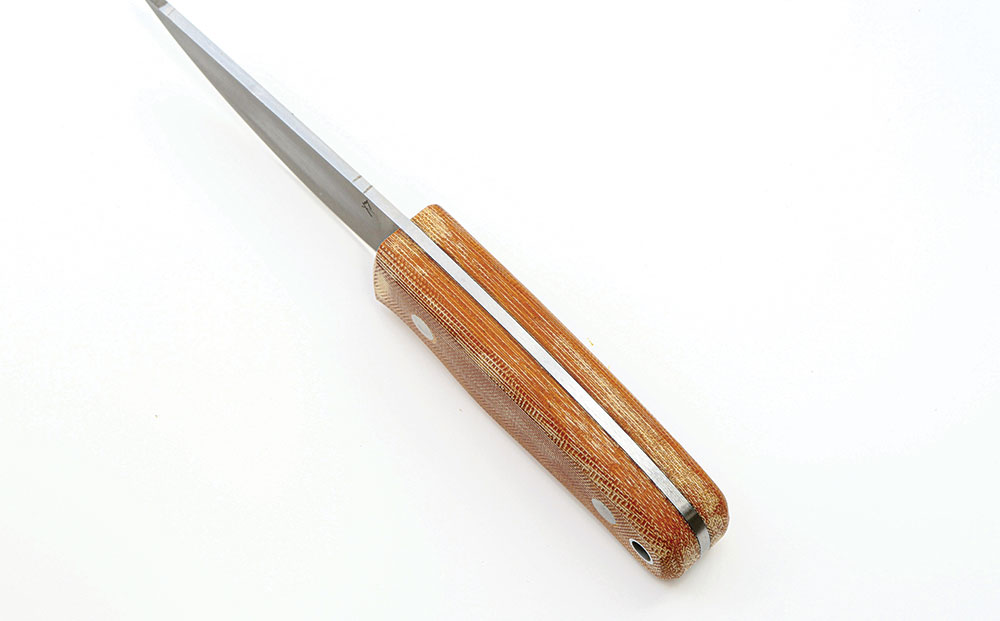
For one, because I was going to be sleeping under the T6ZERO shelter, I needed some stakes. I made a few different types out of greenwood using a basic 7-notch for stakes and traps (as seen in Wowak’s videos). The O1 tool steel bit cleanly into the wood and sliced with the authority that only a Scandinavian grind can offer.
I made a quick figure-4 trap utilizing that same 7-notch and a couple of chisel ends using a chest-lever grip—which is another technique Wowak demonstrated in his videos. I used a baton on the spine of the Mineshaft to drive the blade into the greenwood, making the stop cuts and carving them out with the blade in a chest-lever grip. However, this time, it wasn’t for removing large amounts of wood: It was for a controlled cut, with my left thumb assisting.
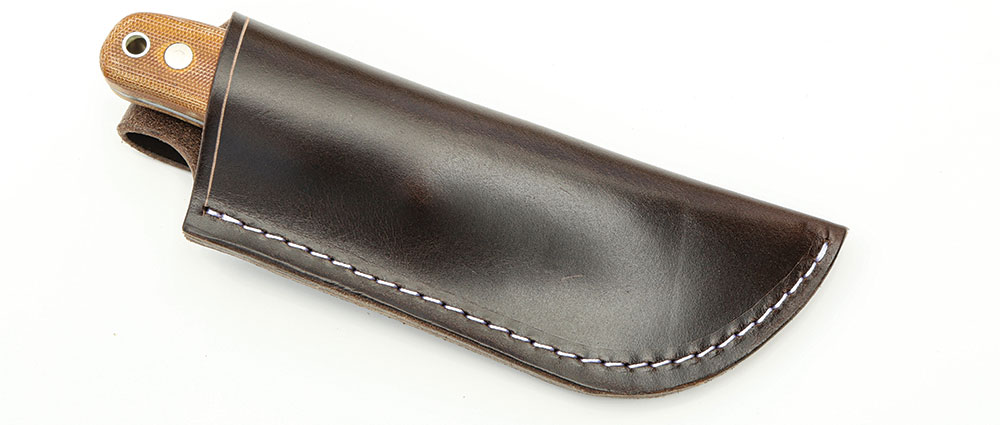
Basic fire preparation is on the list of tasks required from a fixed-blade knife. I split the wood with the help of a baton and shaved it down to create feather sticks for fire-making. This was another task that the Scandinavian grind excelled at. The belly made nice, thin curls, which are essential for catching a spark from a ferrocerium rod or a match. I worked with soft, straight-grained wood, as well as hard oak, with the Mineshaft. Neither was a challenge for the 1/8-inch-thick, 4-inch-long blade.
Food preparation is something no good bush knife can avoid. The Mineshaft sliced onions, jalapeños, peppers and tomatoes for tacos. Carrots, onions and celery were cut for stew. I also sliced bacon and wild green onions for omelets.
“COALCRACKER BUSHCRAFT COURSES SHARE OUTDOOR EXPERIENCES AND EXPERTISE IN THE HOPES OF CREATING A BETTER AND MORE ENJOYABLE EXPERIENCE FOR ITS STUDENTS.”
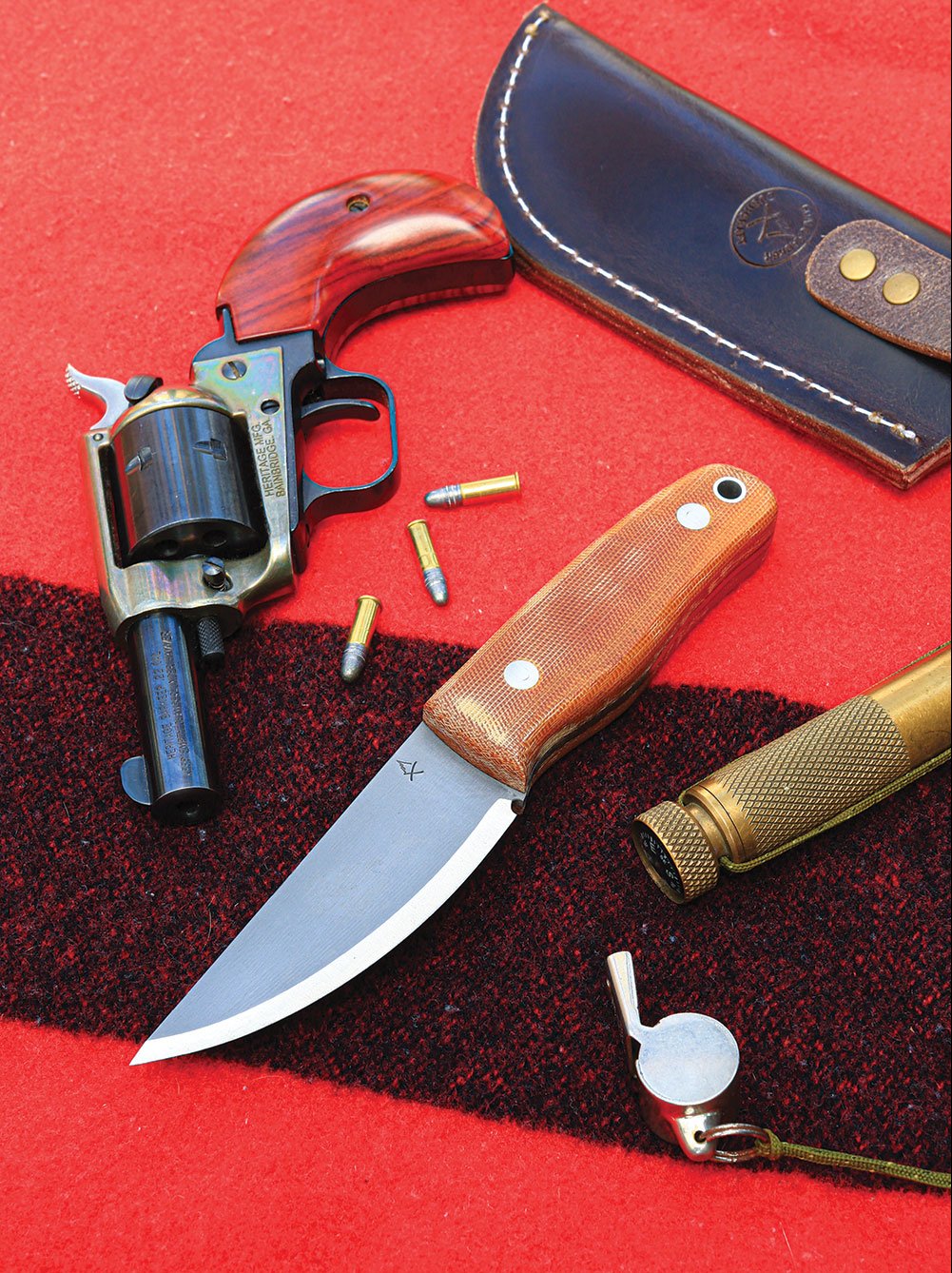
By then, the patina was really materializing. Not many blades will get a patina quite like O1 steel. I’ve used this steel in the past and, next to 1095 high-carbon steel, this is my favorite. People say it rusts if you “look at it wrong,” but I say, Use it! The more exposure to natural acids and oils from meat, the more it will patina and naturally protect itself.
The included brown leather sheath was well made, but it seemed somewhat oversized. The knife was loose in the sheath. However, it wasn’t something a little wet-forming couldn’t fix. Its belt loop is large enough for most belts, and the seam area at the welt has a rough enough area for field-expedient, coarse stropping. The belt loop surface is smoother for a finer strop. The bottom of the sheath has a small space between the welt and the main leather to act as a drain hole.
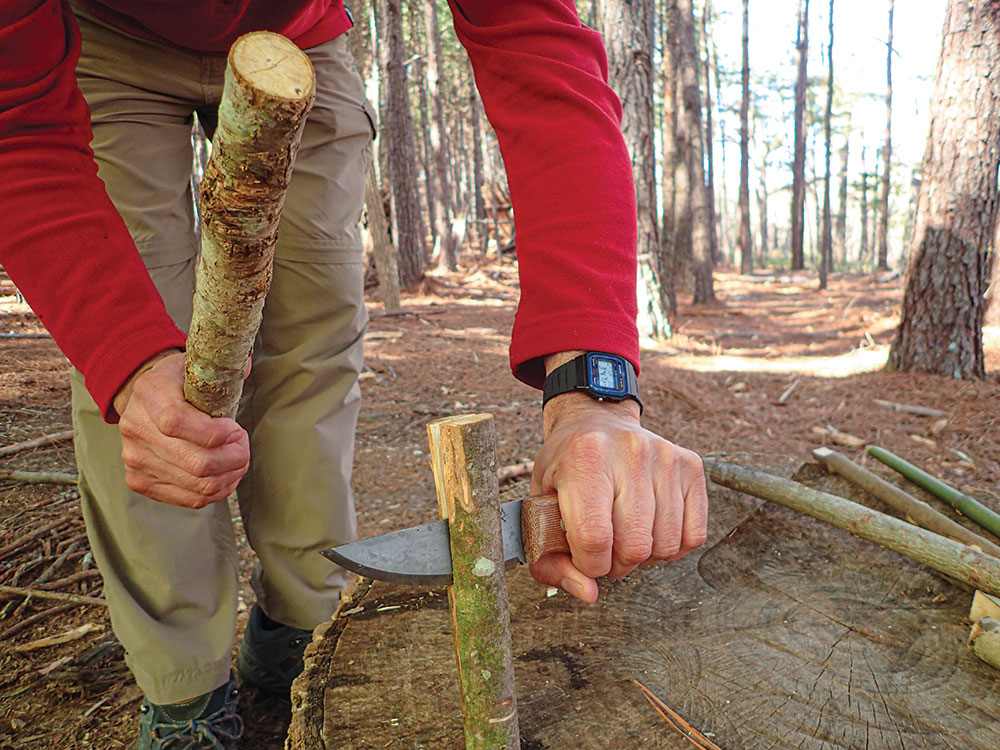
The Mineshaft knife was used for a variety of chores and remained sharp and comfortable … despite its bulky handle. People with extra-large hands would really appreciate it. There was no discomfort and no hot spots. Its spine and blade performed amazingly well. I sharpened the blade with a medium and then an extra-fine diamond stone before a final strop, after which the Mineshaft and I were back in business!
Mineshaft Knife
Specifications
• Overall length: 8 inches
• Blade length: 4 inches
• Blade steel: O1 tool steel
• Blade thickness: 1/8 inch
• Blade grind: Scandinavian
• Handle material: Natural canvas Micarta
• Sheath: Brown bridle leather
• Weight: 7.5 ounces (10 ounces with sheath)
MSRP: $200
Endless Journey
Coalcracker Bushcraft isn’t just a guy making videos and offering a few random classes. Dan Wowak can’t be defined simply as a guy who spent 51 days on a TV show.
“Since the beginning, Wowak felt it was his company’s mission to create passion for the outdoors.”
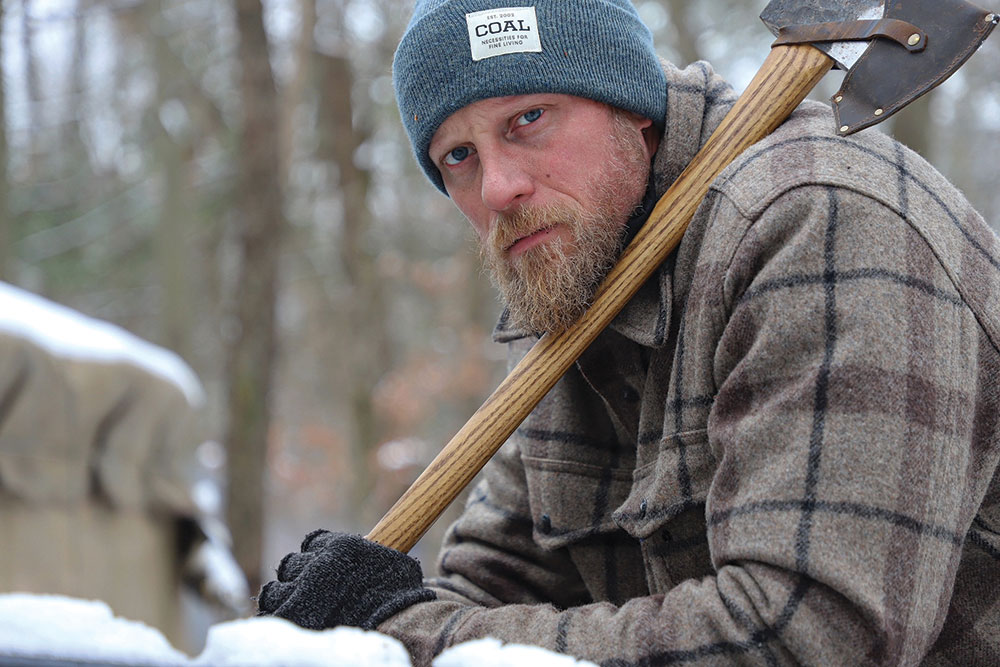
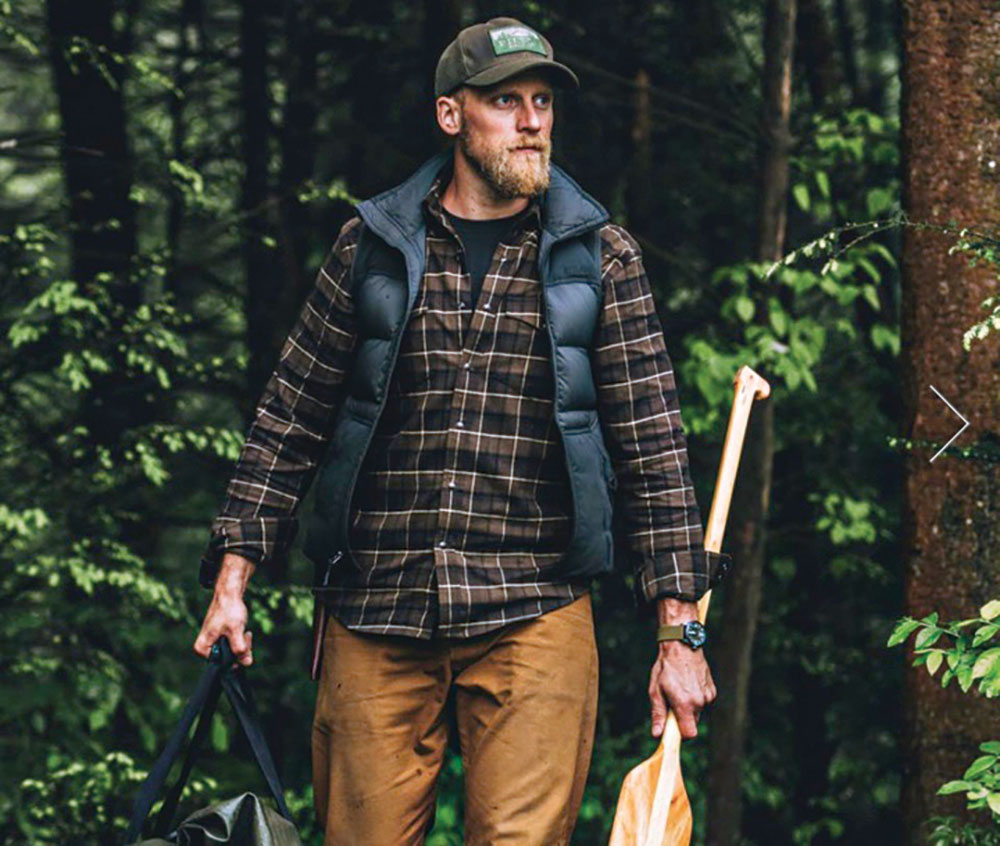
He’s a lifelong student of the wilderness arts, with no graduation day in sight. He’s still on the journey he started all those years ago, except that now, he runs a business that rose from all his hard work and discipline. In addition, he’s assembled a team of people who design, manufacture, teach and share their outdoor expertise. And that’s what sets them apart from other bushcraft/survival camps and defines the essence of Coalcracker Bushcraft.
APPALACHIAN BUSHMAN SCHOOL
Coalcracker Bushcraft is not a one-man show. Along with Dan Wowak, instructors Kian Pederson, Mike Gasper and Sara-Jo Fegley offer a variety of courses throughout the year. This year’s schedule includes Basic & Advanced Survival, Basic & Advanced Bushcraft, Navigation, Modern Bushcraft and a Bushman class. Listed on the website are course descriptions, field and classroom work, required kit, level of physicality and course prerequisites.
“Every day, we work on making better products and enhancing our teaching to serve the people who matter most—our customers and fellow outdoor adventurers!” —Coalcracker Bushcraft
Time Alone
Dan Wowak was a cast member on History Channel’s third season of Alone. The struggle for food seems to be the one thing he names as his constant battle during his time in Patagonia.
He never encountered small game, preventing him from utilizing one of his bushcraft strengths—trapping. So, he paced himself to conserve energy and set lines for fish. He caught only nine fish during almost eight weeks in the wild.
Some of them were tangled around a log and undergrowth in the lake, forcing him into the frigid water to retrieve them or starve. Wowak devoured these fish completely, even eating fish-head soup to get as many of the nutrients and calories as possible.
He lasted 51 days and lost approximately 54 pounds. His extreme weight loss is one the questions he encounters most often from fans of the show. But not surprisingly, in spite of the dire circumstances in which Wowak found himself, he says that if given the chance, he’d do it again.
Here are the 10 items Dan selected for his trip to Patagonia:
- Full-sized felling axe
- Knife with a high-carbon-steel blade
- 30-inch bow saw
- Sleeping bag rated to -20 degrees (F)
- Hammock
- Paracord
- 2-quart bush pot with handle
- Ferrocerium rod
- Fishing gear: 25 hooks; 8- and 20-pound test line
- Rations
SOURCE
Coalcracker Bushcraft
CoalcrackerBushcraft.com
A version of this article first appeared in the August 2021 print issue of American Outdoor Guide.

